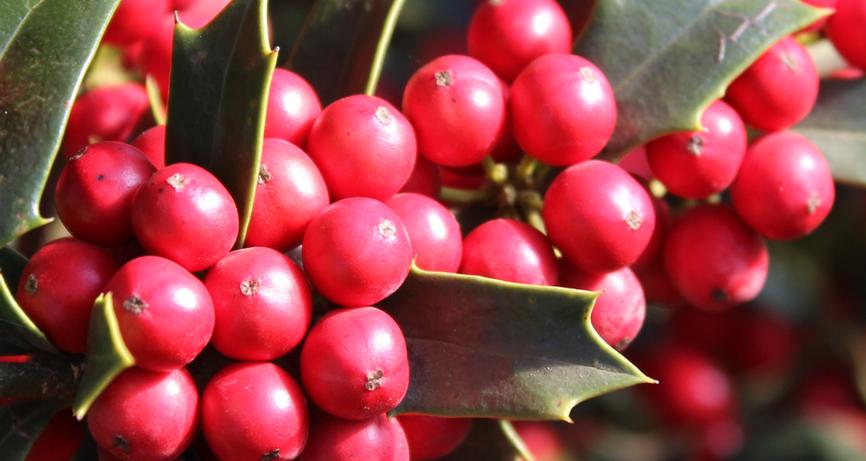
Christmas Jewel Holly
Pollination 101
The Great Pollination Adventure: Decoding Dioecious and Monoecious Plants
Have you ever found yourself staring at your garden, scratching your head, and wondering, “How in the world do I get my plants to bear fruit?” You’re not alone! Let’s dive into the fascinating world of pollination, where we’ll uncover the secrets of dioecious and monoecious plants. Don't worry— we'll make it simple, informative, and sprinkle in a bit of humor along the way.
Dioecious Plants: The Social Networkers of the Plant World
Dioecious (pronounced dye-ee-shus) plants are like the social butterflies who need to mingle to get things done. These plants have separate male and female individuals, meaning that one plant will only have male flowers, and another will only have female flowers. For these plants to reproduce, you need both a male and a female plant nearby. The male plant produces pollen, which must be transferred to the female plant for fertilization—think of it as a botanical date night.
Fun Fact
It’s estimated that about 5% of plant species
fall into the dioecious category.
They’re the rare gems of the plant world!
Some classic dioecious plants include:
- Holly (Ilex): Festive and prickly, these require both Mr. and Mrs. Holly to produce those iconic red berries.
- Ginkgo (Ginkgo biloba): Ancient trees that separate their male and female roles, just like Hollywood stars at an awards show.
- Juniper (Juniperus): These evergreens need their male and female counterparts to produce those flavorful berries.
- Grape (Vitis): Vineyards need both male and female vines to produce the delicious grapes for your favorite wines.
- Pecan (Carya): Nutty and nutritious, they need a duet to fill up your holiday pies.
- Pistache (Pistacia): Delicious pistachios depend on both male and female trees to flourish.
Monoecious Plants: Nature's Do-It-All Wonders
Monoecious (pronounced moh-nee-shus) plants are the multitaskers of the plant kingdom. They have both male and female reproductive organs on the same individual plant. This means a single plant will produce both male and female flowers or cones, making them self-sufficient in their reproductive endeavors. The term "monoecious" comes from Greek word monoikos, where mono means "one" or "single," and oikos means "house." In other words, both types of reproductive organs are under one roof. These plants are nature’s independent superstars.
Fun Fact
It’s also estimated that a whopping
95% of plant species are hermaphroditic,
comfortably fitting into the monoecious category.
Some everyday monoecious plants include:
- Maple (Acer): Trees that light up your fall with their vibrant colors.
- Birch (Betula): Graceful trees with striking white bark.
- Dogwood (Cornus): Spring stunners with their showy blossoms.
- Ash (Fraxinus): Sturdy and stately, often found in parks.
- Honeysuckle (Lonicera): Sweet-smelling and often a favorite of hummingbirds.
- Pine (Pinus): Tall, evergreen sentinels producing cones.
- Oak (Quercus): Majestic giants providing acorns for squirrels.
- Spruce (Picea): Classic conifers perfect for Christmas and beyond.
Note: Nearly all conifers are monoecious, making them the overachievers of the plant world.
Fun Fact
Almost all native plants are monoecious,
highlighting the dominance of this divinely created
reproductive strategy in the natural world.
Some Special Categories Within Monoecious Plants
Even among the multitaskers, there are amazing ways to how these plants handle reproduction.
Dichogamous Plants:
- Definition: These plants produce male and female flowers at different times to avoid self-pollination. It's like hosting separate events to keep the guests from mingling.
- Pollination: They rely on external pollinators like insects or the wind to transfer pollen and ensure fruit production.
Hermaphroditic (Perfect) Flowers:
- Definition: These flowers contain both male (stamens) and female (pistils) reproductive organs within the same bloom. They’re the ultimate all-in-one package of perfection.
- Pollination: They can self-pollinate, but many depend on external factors like insects, wind, or rain to help the pollination process succeed.
- Autogamous: Some of these efficient plants can self-pollinate without any external assistance, ensuring they always reproduce successfully.
Parthenocarpic Pollination:
Parthenocarpic plants are the magicians of the plant world, producing fruits without any fertilization.
- Definition: This is the process of fruit production in some plants that requires no fertilization. The results would be a completely seedless and sterile fruit which can be a huge advantage in environments where pollination and fertilization are tricky or unreliable.
The term comes from the Greek words parthenos (meaning "virgin") and karpos (meaning "fruit").
- Pollination: This process results in the development of seedless fruits, parthenocarpy can occur naturally in some plant species, or it can be induced artificially through horticultural techniques. Imagine getting fruit without the fuss of seeds—sounds like a dream come true for both plants and fruit lovers!
A great example of some parthenocarpic plants are a few members of the Ilex genus. While most hollies are dioecious and require both male and female plants to produce berries, some parthenocarpic varieties can produce fruit without fertilization. Notable parthenocarpic hollies include:
- Nellie R. Stevens Holly: A standout in the holly family, known for its exceptional beauty and practicality. This hybrid holly is a cross between Ilex cornuta and Ilex aquifolium, combining the best traits of both parents. Nellie R. Stevens is particularly favored for its vigorous growth, dense foliage, and stunning red berries.
- Christmas Jewel Holly: Another stellar member of the holly family, prized for its compact size and prolific berry production. As its name suggests, this holly shines brightly during the holiday season, offering a festive touch to any garden. Renowned for its impressive berry production, Christmas Jewel produces a generous amount of bright red berries that last through the winter.
This clever strategy ensures fruit production even when the usual pollinators are scarce, making parthenocarpic plants resilient and reliable producers. So, next time you enjoy a seedless fruit, give a nod to the marvel of parthenocarpy, nature’s way of ensuring the show goes on without a hitch.
Key Insights
Understanding these terms and the reproductive strategies of plants is essential in horticulture, agriculture, and botany. It provides valuable insights into how plants propagate and thrive in various environments, ensuring your garden or farm is full of life.
So next time you stroll through your garden, impress your friends with your newfound knowledge about the social dynamics of plants—whether they’re the social dioecious types needing a partner, or the self-sufficient monoecious varieties.
Happy gardening!



